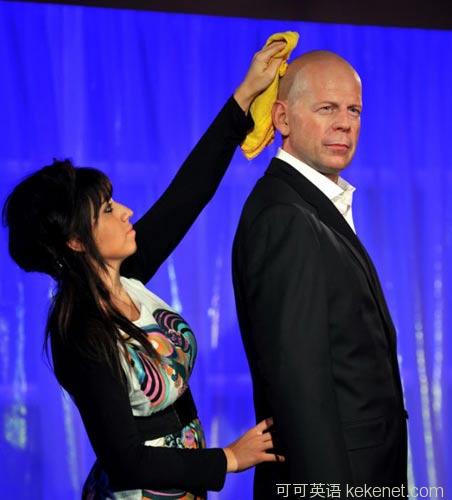(单词翻译:单击)

Bald men are perceived to be more dominant, more athletic and better leaders, researchers have claimed.
研究人员称,人们普遍认为秃头男更具主导力、更健壮、领导能力更强。
A new study from information management lecturer Albert Mannes at the University of Pennsylvania's Wharton School of Business suggests that while men with male-pattern baldness tend to view themselves as having poor self-esteem, those who take the pre-emptive step of shaving a thinning head of hair improved their image.
美国宾夕法尼亚大学沃顿商学院的信息管理系讲师阿尔伯特?曼尼斯开展的一项新研究指出,尽管谢顶男子往往会因为脱发而感到自卑,但那些在头发掉光前就先行一步剃光头的男人形象则会有所改观。
'The broad take-away is that perceptions about leadership and related traits like dominance can emerge from peculiar characteristics that aren’t really related to leadership at all,' says Mannes.
曼尼斯说:“从研究中获取的大致信息是,领导能力,以及如主导力这样的相关特质,可以从一些和领导力本身并无实质关系的个人特征中感受到。”
For the paper, 'Shorn Scalps and Perceptions of Male Dominance,' published in the journal Social Psychological and Personality Science, Mannes describes three experiments.
这篇题为《秃头和对男性统治力的认知》的论文发表在期刊《社会心理和人格科学》上。在论文中,曼尼斯描述了三个实验。
The first found men with shaved heads were viewed as more masculine and dominant than other men.
第一个实验发现,剃光头的男子被认为比其他男性更有男子气概,更具主导力。
Two more experiments found men were perceived as taller (by an inch, on average) and stronger (that is, seen as being able to bench press 13% more) than those men with a full head of hair.
另外两个实验发现,光头男子看上去比头发浓密的男子更高(平均多出一英尺)、更强壮(光头男被认为能做仰卧推举的比例要多出13%)。
They were also viewed as having greater potential as leaders.
此外,光头男还被认为具有更高的领导力潜质。
Mannes said the impetus for his research came from his own experience in his early thirties, when he began losing his hair.
曼尼斯说,他做这项研究的原动力来自他三十出头就开始谢顶的亲身经历。
In the first experiment, subjects were asked to look at a series of photographs of men of similar age and dress, including some with shaved heads.
在第一个实验中,研究人员让参与者观看年龄和服饰相近的男性的一组照片,其中包括一些剃光头的男性。
Then, they were asked to rate the men in terms of how powerful, influential and authoritative they looked. When the numbers were tallied, the shaved heads won.
接着,研究人员让他们根据这些男性的外观给他们的权力、影响力和权威性打分。把这些数字加在一起,光头男胜出了。
In a second experiment, Mannes tried to control for other physical features that could convey dominance by showing his subjects the images of four men, but in two different versions: one with their hair, and one with their hair digitally removed.
在第二个实验中,曼尼斯试图控制其他让人感受到主导力的外貌特征,只让参与者看四名男性的照片,但是版本不同:一个是有头发的版本,另一个是用数码技术将头发修掉了。
Again, the images of men without hair were perceived as more dominant — and, much to Mannes’ surprise, also taller and stronger.
光头的男子形象再次被认为更具主导力,而且,让曼尼斯十分惊讶的是,他们还显得更高更强壮。
For his third experiment, Mannes avoided all visual cues and offered subjects physical descriptions of men, including whether they had hair, thinning hair or a shaved head.
在第三个实验中,曼尼斯避免所有视觉提示,给参与者描述了男性的外貌,并描述了他们是有头发、头发稀疏或是光头。
Again, the shaved men came out on top.
结果同样,光头的男子胜出。
However, there were downsides. Men with shaved heads were rated lower in attractiveness and also seen as being older. But they nonetheless scored higher than men with thinning hair, who were ranked lower in almost all categories.
然而,剃光头也有不利的一面。剃光头的男子被认为不太有吸引力,而且看上去更老。不过他们的得分还是比头发稀疏的男性要高,这些人几乎在所有评比项中都处于下风。


